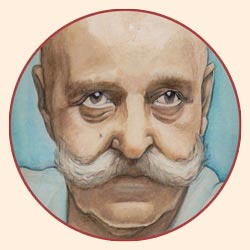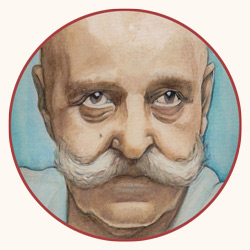Brahma, Shiva, and Vishnu | Guler, 1770
Workshop on the Laws of Three & Seven
24 – 29 October 2022
$550 USD (Installments Possible)
BePeriod invites you for a week-long online workshop on the Law of Three and Law of Seven. We will meet for six consecutive days to deepen our understanding of these laws, how they manifest during our daily activities, how they factor into our psychology, and how they were presented in ancient teachings. Each session will span two hours with an intermission, and will conclude with a practical exercise to be applied throughout the following day. The group’s verifications from this exercise will lay the ground for the consecutive session. (The sessions will be recorded and made available for viewing afterwards.)

Everything in the Universe is one, the difference is only of scale; in the infinitely small we shall find the same laws as in the infinitely great. As above, so below.
Session #1: Overview of Laws
We will begin our workshop by examining the general function of laws.
The ancients envisioned the universe as a tree. From the trunk of its creator branched out exponential worlds: each galaxy branched into suns that branched into solar systems that branched into planets that branched into moons. Those tiers closer to the trunk enjoyed its direct influence, those farther away drifted into inevitable isolation. The creator compensated for this isolation by instating laws. In drawing away from the trunk, each tier came under more laws that guaranteed order be maintained. Among these laws, the two most fundamental were the Law of Three and the Law of Seven.
The Law of Three dictates that every phenomenon is the result of the interaction between three forces. The Law of Seven dictates that no process unfolds without interruption. In this first session, we will give a few examples of the manifestation of these laws and adjourn with an experiment aimed to help observe them in action.
Vishvarupa with the three realms | Jaipur 1800-1850
In the Absolute there is only one force and only one law—the single and independent will of the Absolute. In the next world there are three forces or three orders of laws. In the next there are six orders of laws; in the following one, twelve, etc.
George Gurdjieff

Surya (Sun God) | Pahari, 1720
Session #2: The Six Processes
Having surveyed the theory behind the Laws of Three and Seven, we must now examine their relation to each other. For this end, we study their manifestation in the worlds immediately adjacent to us: sun, planets, and earth.
The sun is the source of life on earth; it bathes living beings with light and warmth. The earth is the source of raw material; it lends living beings the components for their physical bodies. And according to the ancients, there was an additional influence that mediated between the sun’s life-force of the earth’s matter: the influence of the planets. Planetary influence dictated the form of everything living. Consequently, organic life on earth was regulated by an interplay between sun, earth, and planets, or life, matter, and form.
Life, matter, and form interact in six possible combinations to create six possible triads. Three triads result in ascending octaves, three in descending octaves. In our second session, we will review the theory behind these six process and begin observing them play out in our daily lives.

Session #3: Third Force
In the Law of Three, the active force is usually self-evident. The resistance is also usually simple to detect. But the third force is elusive. To learn to recognize the third force, we will examine its presentation in Hinduism.
Avatars of Vishnu
Hindu philosophy viewed each world as a cosmos whose existence depended upon an equilibrium between good and evil. As long as these two forces counterbalanced each other, the cosmos functioned in peace. But ever so often the forces of evil gained the upper hand over the forces of good, tilting the cosmos off balance. In these instances, the god Vishnu was responsible for restoring order. He did so by incarnating into various physical forms that suited the occasion.
In each of these myths, Vishnu (life) assumes a physical body (matter) of an optimal nature (form). The myths of Vishnu’s Avatars, therefore, serve as studies on the elusive third force. We will end this session by returning to our first exercise and attempting to apply third force to our task consciously.
Folio Of The Avatars Of Vishnu | Kashmir, 1819
Two forces cannot produce anything—they will only turn round one another without any result. It takes a long time to begin to see three forces in things—for some reason we are third force blind.

Jarasandha fighting with Balarama | c. 1810, Kangra
Session #4: Active and Passive Forces
In this current age, Vishnu is considered to have incarnated nine times. The myths around each of his Avatars are usually stories of war, because the balance between good and evil can only be restored through struggle. In this session, we will review two of his most famous avatars.
The Ramayana
Vishnu’s seventh incarnation appears at a time in which Ravana, the evil king of Lanka, has gained disproportionate strength. Vishnu incarnates as prince Rama who is unjustly exiled from his kingdom. As he roams the forests with his wife Sita and brother Lakshman, Ravana sets his eyes on Sita, falls in love with her, and abducts her. Rama will eventually wage war on Lanka, defeat Ravana, retrieve Sita, and return as victor to his rightful kingdom.
The Mahabharata
Vishnu’s eighth incarnation appears at a time of conflict between two groups of cousins, the Pandavas and the Kauravas. On the verge of war, Arjuna, a member of the Pandavas, understandably experiences deep hesitation to fight his relatives, and halts his chariot in mid battle. Vishnu incarnates as Krishna, Arjuna’s charioteer, who counsels him the knowledge of the Bhagavad-Gita to help him overcome his moral dilemmas.
In the Ramayana we will witness the process of crime and the restoration of justice. In the Bhagavad-Gita, the role of understanding as reconciling force between effort and resistance.

Inner unity is obtained by means of ‘friction,’ by the struggle between ‘yes’ and ‘no’ in man. If a man lives without inner struggle, if everything happens in him without opposition, if he goes wherever he is drawn or wherever the wind blows, he will remain such as he is. But if a struggle begins in man, and particularly if there is a definite line in this struggle, then, gradually, permanent traits begin to form themselves, he begins to ‘crystallize’.
George Gurdjieff
Session #5: Transformation
The six processes were recognized by medieval alchemists, who were particularly keen in understanding the mystery of transformation. How could the coarse metal of lead be turned into gold?
The Churning of the Milky Ocean
Vishnu’s second Avatar offers an answer to this riddle. In a typical moment of historical crisis, the equilibrium of the world is once again thrown off balance. Its inhabitants petition Vishnu for help, who advises gods and demons to churn the ocean of milk to retrieve the lost nectar of immortality. They take Mount Mandara as a rod, the serpent Vasuki as a rope, and begin tugging.
The two forces now pull against each other from either side of the mountain—but where is the third force? Lacking a proper foundation, Mount Mandara begins sinking into the ocean, threatening to implode the entire endeavor. Witnessing this, Vishnu incarnates in the form of a giant turtle to support Mount Mandara on his shell and reinvigorate the tugging. The churning proceeds and eventually restores cosmic order.
While gods and demons experience the tugging as almost unbearable, Vishnu’s avatar experiences the pressure on his shell as an ‘infinitely pleasant scratching.’ Herein lies the enigma of transformation: the same effort is experienced in diametrically opposite ways by different parts in us. If we can contain this enigma, our churning yields butter; our struggles give rise to something real and permanent.
Churning of the Milky Ocean | Rajasthan, 1740
Crystallization is possible on a right foundation and it is possible on a wrong foundation. ‘Friction,’ the struggle between ‘yes’ and ‘no,’ can easily take place on a wrong foundation…
George Gurdjieff

Woman Applying Bindi | Pahari, 1800
Session #6: As Without So Within
The Laws of Three and Seven are universal. The proliferation of galaxies differs from the splitting of cells only in scale. Since it is easier to observe large-scale, external phenomena, ancient teachings coined myths to convey the laws that governed world order. These grand epics were meant to reflect their equivalent on the scale of the micro-cosmos human being.
On the micro-cosmic scale, we are Vishnu, we harbor gods and demons. On this scale, we must learn to recognize the denying force of the moment, match it with a corresponding active force, and administer the reconciling environment. We must learn to balance habit with discipline, crime with transformation. We must learn to perform the mystical process of crystallization and render the conscious part in us permanent.
Our week-long workshop will turn these ancient myths into mirrors of our own inner work. It will serve as third force for the practical application of the Laws of Three and Seven.

In right knowledge the study of man must proceed on parallel lines with the study of the world, and the study of the world must run parallel with the study of man. Laws are everywhere the same, in the world as well as in man. Having mastered the principles of any one law we must look for its manifestation in the world and in man simultaneously.
George Gurdjieff
The Ten Avatars of Vishnu | Kangra, 1790







